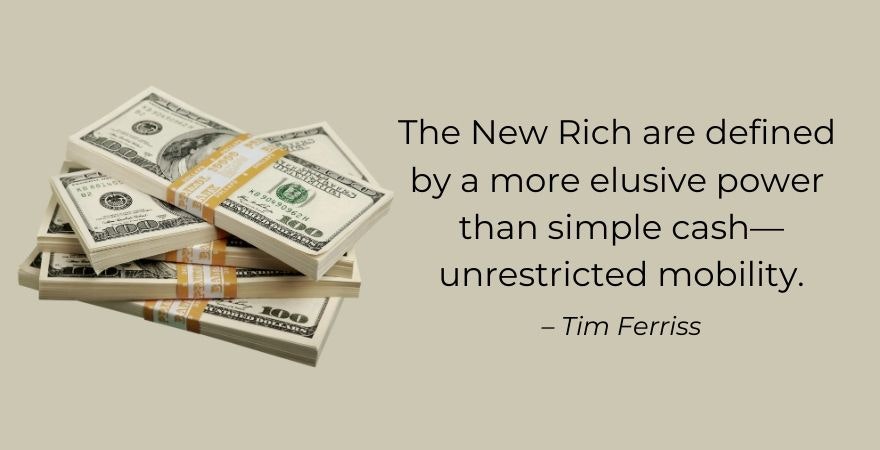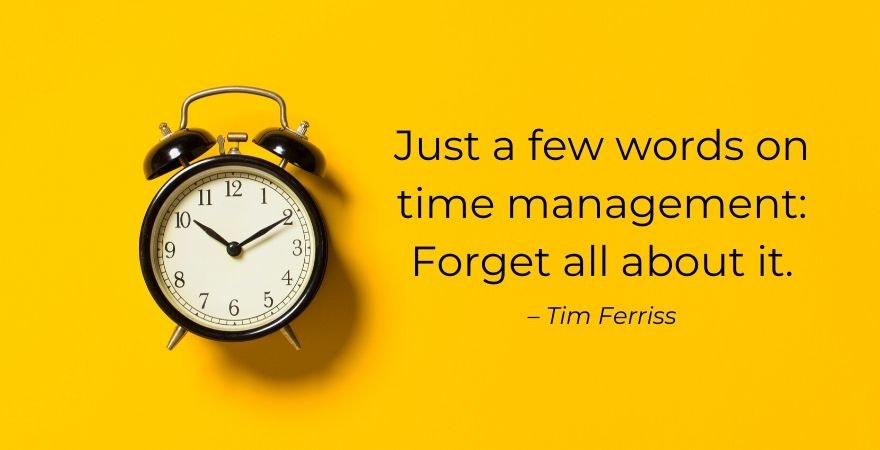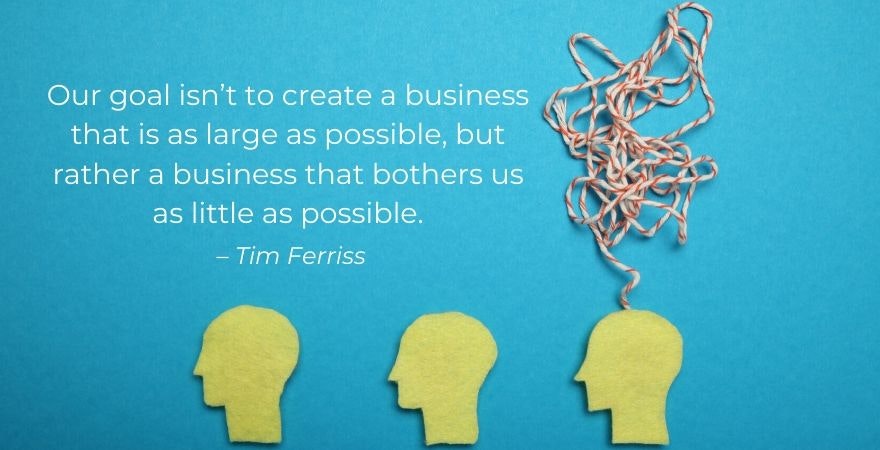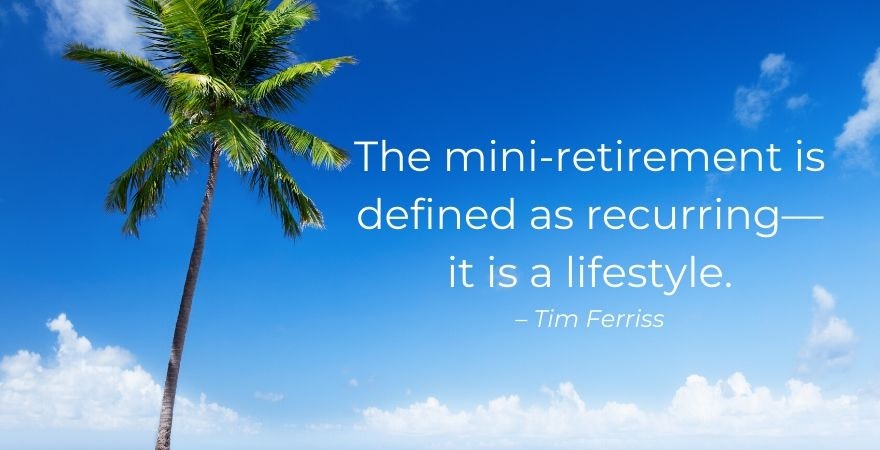Turned down by 26 out of 27 publishers, The 4-Hour Work Week nearly didn’t become the No.1 New York Times Bestseller it went on to be. Tim Ferriss wrote ‘The 4-Hour Work Week’ for all those tired of postponing their life until retirement, who instead want to live life large and in the moment, right now.
In The 4-Hour Work Week, Ferriss promises a way to get all the rewards of working without having to wait until the end of your career. As a testament to his strategies, Ferriss has used them to become (amongst many other things):
- A guest lecturer at Princeton University
- The first America Guinness World Record holder in tango
- The advisor to over 30 world-record holders in both professional and Olympic sports
- A national Chinese kickboxing champion
- An MTV breakdancer in Taiwan
Post Contents

Don’t wait for someone else to do it. Hire yourself and start calling the shots.
Get Started FreeWhat is The 4-Hour Work Week about?
The 4-Hour Work Week aims to give you more time and more mobility. These are two of the defining attributes of what Ferriss refers to as the “New Rich.” The New Rich have abandoned the deferred-life plan to create luxury lifestyles in the here and now, and Ferriss argues that you can too.
Ferriss states that people don’t want to be millionaires; they want to experience what they think only millionaires can buy. The question, therefore, is how can you achieve the lifestyle of a millionaire, without having a million dollars in the bank? Over five years, Ferriss set out to answer this question and has laid out the key to separating income from time. Consequently, ‘The 4-Hour Work Week’ is not about how to save, or about finding your dream job; it’s about how to free up the most time, and automate your income.
How ‘The 4-Hour Work Week’ review is structured
To become part of the New Rich, Ferriss puts forward a set of strategies to follow that spell out the acronym, DEAL. The book looks at each of the following in turn:
- D for ‘Definition:’ Turns misguided common sense on its head, and instead introduces new rules and objectives.
- E for ‘Elimination:’ This step argues for the elimination of the concept of time management.
- A for ‘Automation:’ Looks at putting your cash flow on autopilot.
- L for ‘Liberation:’ Liberation is not necessarily about cheap travel; it’s about being free from the binds that keep you tied to a single location.
The 4-Hour Work Week summary will look at each feature of Ferriss’ DEAL acronym, extracting the key points so that you can learn how to become a member of the New Rich.
Step 1: D is for Definition
Ferriss argues that the defining feature separating the New Rich from what he refers to as the ‘deferrers’ (i.e., those saving up all of their money for retirement), is their goals and their philosophies. He lists a few of the distinctions between these two modes of thinking as follows:
- Deferrer = I want to work for myself
- New Rich = I want to have others to work for me
- Deferrer = I want to work whenever I want to
- New Rich = I prevent work for work’s sake and do the minimum to get the maximum
- Deferrer = I want to retire young
- New Rich = I want to regularly distribute adventures and recovery periods throughout my life. Inactivity is not the goal, but doing what is exciting is
- Deferrer = I want to buy all the things I want
- New Rich = I want to do all the things I want to do
- Deferrer = I want to have a lot of money
- New Rich = I want to make a lot of money for specific reasons with defined dreams
- Deferrer = I want to have more
- New Rich = I want to have more quality and less clutter

Ferriss states that the deferrer’s desire to chase money blindly is foolish. If you can free up your time and your location, your money is automatically worth three to ten times more, as you are no longer paying rent. Ferriss chartered private planes over the Andes, enjoyed the finest wines in the world, and lived like a king in a private villa, which all cost less than paying rent in the U.S. Consequently, Ferriss states that money is multiplied in practical value according to the four W’s:
- What you do
- When you do it
- Where you do it
- Whom you do it with
This means that an investment banker making $500,000 a year for 80 hours a week, is less “powerful” than a member of the New Rich working 20 hours a week for $40,000, but who has complete freedom over the when, whom, where, and what of their lives. It’s the ability to choose that is our true power. The 4-Hour Work Week is all about identifying and creating these options so that you can make more money while working less.
Rules that change the rules
When the world seems to be defining or solving a problem in a way that continuously creates subpar results, you need to ask yourself: What if you did the opposite? For example, when Ferriss was working in a sales department, he realized that most cold calls didn’t get through to their intended recipient. So, he decided to only call businesses between 8:00 a.m. – 8:30 a.m. and 6:00 p.m. – 6:30 p.m. By doing so, he avoided the secretaries. He also got twice as many meetings as his colleagues who were calling from 9:00 a.m. – 5:00 p.m., for an eighth of the time.
To be a part of the New Rich, Ferriss offers ten rules that are fundamental to your success:
- Retirement is the worst-case-scenario insurance. It rests on the assumption that you are doing something you dislike for the ablest years of your life rather than enjoying those years now.
- Interest and energy are cyclical. Alternating between periods of rest and activity is essential. The New Rich distribute ‘mini-retirements’ throughout their life, instead of hoarding it all for retirement.
- Less is not laziness. Despite spending fewer hours in the office, the New Rich produce more meaningful results than a dozen deferrers combined.
- The timing is never right. Holding out for the perfect moment to make a decision will rarely come to fruition. Waiting for ‘someday’ means that you will take your dreams to the grave.
- Ask for forgiveness, not permission. People deny things according to their emotions, but they can learn to accept them after the fact.
- Emphasize strengths. Don’t fix weaknesses. By improving your strengths over your weaknesses, you focus on multiplying the results as opposed to incrementally fixing your flaws.
- When things are done to excess, they often take on the characteristics of their opposites. Too much and too often of what you want will soon become what you don’t want.
- Money alone is not the solution. We often use not having enough money as a scapegoat for not self-reflecting and working out what we want out of life.
- Relative income is more important than absolute income. Relative income looks at both money and time, whereas absolute income only looks at money. The former is how the New Rich assesses their current worth.
- Distress is bad, eustress is good. Distress refers to harmful stress that makes you weaker. Eustress refers to the type of stress that helps you grow. The New Rich seek out eustress and reject distress.
Dodging bullets
Uncertainty and the prospect of failure prevent people from trying new things. Most will choose unhappiness over uncertainty. Ferriss suggests that if fear is preventing you from making a choice, imagine the worst-case scenario in detail. Then, work out how you could salvage your life if the worst came to pass.
This is a technique he used when he was unhappily working 15-hour days to run his company and was debating whether he could take a holiday or not. In the end, he realized that if the worst happened, it wouldn’t be fatal, he would survive, and he would be able to get back on track.
Ferriss offers seven questions to ask yourself to help you overcome your fears:
- What is your absolute worst-case scenario?
- What could you do to repair the damage if this came to pass?
- What are the temporary and permanent outcomes and benefits of more probable scenarios?
- If you were fired today, how could you take care of your finances?
- What are you putting off due to fear?
- What is the cost (emotionally, financially, and physically) of postponing action?
- What are you waiting for?
System reset
Ferriss states that doing the unrealistic is easier than doing the realistic. As 99 percent of the world believes they are incapable of achieving greatness, they aim for a mediocre life. The problem? The level of competition is fiercest amongst those battling to achieve “realistic” goals. Therefore, there is less competition for bigger goals. The real challenge is to work out what you want.
However, the questions ‘what do you want?’ and ‘what are your goals?’ are flawed, they need to be rephrased. Ferriss argues that, generally, we make goals because we believe we are chasing happiness. He thinks this is wrong. Happiness has become ambiguous through overuse, and while most believe sadness to be the opposite of happiness, Ferriss posits that they are two sides of the same coin. The real antithesis to happiness is boredom. Consequently, Ferriss concludes that it’s excitement, which is a better synonym for happiness, and it’s an excitement that you should strive to chase.
Thus, the question shouldn’t be ‘what do you want?’ or ‘what are your goals?’ but ‘what excites you?’ To make what excites you your focus, follow this 3-fold process:
- Shift your goals from ambiguous wants to defined steps
- Make your goals unrealistic so that they can be effective
- Focus on activities to fill the vacuum of work once it’s removed, living like a millionaire requires doing interesting things, not just owning things
Step 2: E is for Elimination
Ferriss claims that we should forget about time management. It’s a trap. You shouldn’t be trying to fill every second with work. Now that you’ve thought about what you want to do with your time, you’ve got to find a way to create more free time while maintaining or increasing your income. The key is to remember that what you do is infinitely more important than how you do it. While efficiency is essential, it’s redundant unless it’s being applied to the right things.

Ferriss utilizes Pareto’s 80/20 Principle. The idea is that 80 percent of output will result from 20 percent of input. This can be applied everywhere, from wealth distribution in society to company profits relative to their products and customers. With this in mind, Ferriss suggests slowing down and remembering that often, being busy is a form of laziness as it prevents you from thinking.
Being selective in what you do, and even doing less is the path to being productive. By working out which 20 percent of your sources are causing 80 percent of your problems, and vice versa, you can adjust your life accordingly.
In addition to the 80/20 principle, Ferriss utilizes Parkinson’s Law. This states that the perceived importance of a task will increase in correlation with how much time has been allotted for its completion. Therefore, you should shorten your work time and limit your projects only to those that are important. How does this work in combination with the 80/20 Principle? By first identifying the few critical tasks that create the most income (80/20), and then scheduling them in with very short, clear deadlines (Parkinson’s Law).
The low-information diet
Ferriss suggests that to move forward as part of the New Rich, you must learn to be selectively ignorant. It’s essential to ignore all information that is irrelevant, unimportant, or unactionable. Most information is time-consuming and redundant. You should critically assess what you look at, read, or watch daily and establish whether it’s contributing to your goals.
Ferriss offers a 3-step procedure to help you eradicate useless information from your life:
- Go on a one-week media fast immediately. This means, no newspapers, magazines, news websites, television, non-fiction books, and unnecessary web surfing.
- Develop the habit of asking yourself if you will use this information for something that is both immediate and important.
- Learn when to stop absorbing. If you’re reading a poorly written article, don’t continue to read it.
Interrupting interruption and the art of refusal
Ferriss defines an interruption as anything that prevents the completion of a critical task, in which there are three principal offenders:
- Time wasters
- Time consumers
- Empowerment failures
To prevent interruption from these sources, consider taking the following steps:
- Create systems that limit your availability and deflect inappropriate interruptions. This could mean replacing a meeting with a concise email.
- Batch activities to limit costs and to create more time.
- Set autonomous rules with regular reviews of results. This prevents creating a decision bottleneck.
Step 3: A is for Automation
Some of the most critical skills necessary for becoming a member of the New Rich are learning how to communicate and to manage remotely. To get used to this idea, Ferriss suggests hiring a digital assistant to practice giving other people orders. An essential facet of being a member of the New Rich is learning how to replace yourself within a system.
However, Ferriss is also keen to highlight the dark side of delegation. Unless a task is well-defined and vital, he states that no one should do it. Eliminate before you delegate. This means never automating something that could otherwise be eliminated, and never delegate something that could be automated. To get to grips with the idea of automating your life, Ferriss suggests the following:
- Hire an assistant—even if you don’t need one
- Start small but think big. This means looking at what’s been on your to-do list for the longest time, examining what causes you the most frustration or boredom, and delegating these tasks
- Identify your five top time-consuming, non-work tasks, and five personal tasks you could assign, just for the fun of it
- Keep in sync by using scheduling and calendars

How to work 4 hours a week
To only work 4 hours a week and to become a member of the New Rich, the key isn’t to run a business. It’s to own a business and spend no time on it. How to do that? Outsourcing. To get the ball rolling, Ferriss states that your business should adhere to the following:
– The target product can’t cost more than $500 to test
– It must be able to be automatized within four weeks
– When established, it can’t require more than one day per week of management
From here, Ferriss provides a step-by-step process for identifying a potential business model that could work for you:
- Pick an affordable niche market. Don’t create a product then go looking for your customers. First, find a market and identify your customers, then develop a product for them. To be successful, you should be a member of your target market. This makes the process significantly easier.
- Brainstorm (and don’t invest in) products. Choose two industries that you’re familiar with that both have their own magazines where a full-page advert costs $5000 or less. Now brainstorm ideas for products that could be effectively advertised in both these magazines. The product should cost between $50 and $200, shouldn’t take more than three to four weeks to produce, and should come accompanied with a thorough online FAQ. Then choose whether you want to either resell a product, license a product, or create a product.
- Then micro-test your products. Micro-testing uses cheap advertisements to test if there is a demand for your product before manufacturing it. Do this by assessing the competition and creating a more engaging offer than them. Then test the offer using short advertising campaigns before deciding which of your potential product ideas to back.
- Once you have a product that sells, it’s time to automate it. The architecture of your business needs to ensure that you’re out of the information flow, instead of at the top of it. To do this, contract outsourcing companies as opposed to freelancers and ensure that all of your outsourcers communicate with each other to solve problems.
- Assess the value of each customer. Identify those customers who spend the least and yet ask for the most (i.e., adhering to the 80/20 rule) and cut them out. They cost far more time than they are worth. Those customers you do keep on, treat well, as if they were in an exclusive club.

Step 4: L is for Liberation
If you are currently an employee for a company and you want to enjoy the unrestricted remote living of the New Rich, there are a few things you can do:
- Increase your employer’s investment in you. This could mean asking for the company to fund you through a training course. The psychology behind this is that the more a company invests in you, the greater the loss if you quit.
- Prove increased output when out of office. You could call in sick for two days but then work from home, doubling your work output and creating tangible proof of your efforts to show your employers how well you work when not in the office.
- Prepare the quantifiable business benefit. This means creating a bullet point list that showcases how much more you achieve when not in the office.
- Propose a remote working trial period. This could start at one-day-per-week.
- From here, gradually increase your remote working time. Do so by ensuring that your remote working days are your most productive then set a meeting with your employer to discuss the results.
Beyond repair – killing your job
Some jobs, however, are simply not worth salvaging. Just because you may have invested a lot of time into a job, doesn’t make it a worthwhile venture. However, as discussed earlier, it’s fear that prevents people from making the leap. Here are four of the most common fears when thinking about quitting a job, and Ferriss’ rebuff to each of them:
- Quitting is permanent: This is a lie. It’s always possible to pick up your chosen career path with a different company at a later date.
- I won’t be able to pay the bills: Yes, you will. If you can get a new stream of income before you quit your job, great, if you don’t, it isn’t hard to eliminate most of your expenses temporarily and live off your savings for a short while.
- Health insurance and retirement funds will cease if I quit: This is false. Do some research and transfer your 401(k) or similar to another company.
- It will ruin my resume: False. Just get creative with your CV. Plus, if you quit to do something interesting, this will often make you more attractive to employers in the long run.
Mini-retirements—embracing the mobile lifestyle
After turning a three-month vacation into a 15-month trip, Ferriss asked himself, “why not take the usual 20-30 year retirement and redistribute it throughout life instead of saving it all for the end?” Consequently, Ferriss suggests that instead of engaging in binge travel (which most people working 40-hour a week jobs do when they get vacation time), that you go on several mini-retirements, which means relocating to another place for six months. By doing so, you will not escape your life as such but will re-examine it.
To get used to the idea of a mini-retirement, you first need to unshackle yourself from the materialism and comparative mindset that is integral to a speed- and size-obsessed culture. In his experience, Ferriss says that it takes around three months to unplug from these obsolete ways of thinking before becoming aware of just how much time is spent distracting yourself by being in constant motion.
When it comes to financing your mini-retirements, your level of luxury is limited only by your level of creativity. When you compare living expenses in a different country to the amount you are currently paying, like Ferriss, you may realize that living abroad could save you money. What’s more, before going away, it’s an excellent excuse to declutter your life from all its unnecessary belongings. This is the perfect time to use the 80/20 rule to ask yourself: What are the 20 percent of your belongings that you use 80 percent of the time, and vice versa? Then get rid of the excess.

Filling the void—adding life after subtracting work
It’s not uncommon that once you arrive on your mini-retirement, a gaping void engulfs you where you would otherwise have been busy distracting yourself with work. This frequently happens to those who retire, and it is what happened to Ferriss on his inaugural mini-retirement. The first thing to do is not to freak out as this is normal. The more goal-orientated you are, the more challenging this transition is going to be. In addition, you may also find yourself suffering from social-isolation.
In the absence of an external focus, the mind turns inwards and can create more problems to solve than necessary. However, if you find a focus or a goal, these problems can dissipate. If you find yourself mulling over existential questions without being able to get yourself out of a rut, Ferriss suggests asking yourself two things:
- Have you given each term in this question a specific definition and meaning?
- Will the answer to this question be acted upon to improve your life?
Consequently, if you can neither define it or act upon it, you should forget about it.
Overall, the most important things in life are to enjoy yourself and to feel good about yourself. While he cannot offer a single answer to the question of how to enjoy life and feel good about yourself, Ferriss does state that two components are fundamental to the New Rich: service and continual learning.
Ferriss suggests that one of the best things you can do when on a mini-retirement is to learn a language. According to him, it hones your clear thinking while allowing you to get to grips with the culture you are immersed in. Further, Ferriss defines service as doing something that improves life beyond your own. It’s an attitude, and it’s up to you to find the area that most appeals to you and to do your part.
To help you to prepare for your mini-retirement, Ferriss suggests the following:
- Revisit ground zero: Do nothing. You cannot escape your inner demons before you face them. Consider attending a short (three – seven day) silence retreat in which all media and speaking are prohibited.
- Anonymously donate to a service organization of your choice. This can help give you ideas of what type of service you’d like to contribute to in the world.
- Combine a learning mini-retirement with local volunteering. While on the trip, note any self-critical or negative self-talk in a journal, and if you get upset or anxious, ask yourself why.
- Revisit and reset your dream lines. Your mini-retirement may have given you a greater perspective on what you want to get out of life.
- Based on the results of steps one to four, consider trying out a new part- or full-time vocation. A vocation is different from work. A vocation is a true calling or a dream occupation.
The last chapter
Once you discover that life is not a problem to be solved or a game to be won, a real world of opportunities opens up. By mindlessly chasing an ideal of success, you miss out on all of the fun, especially when you recognize that the only rules and limits that exist are those that you set for yourself. You can recapture the magic of your childhood. Indeed, this is required. When you do so, you will realize that there are no more chains, or excuses, holding you back from living the exciting, fulfilling life you previously could only ever have dreamed of.
You can buy ‘The 4-Hour Work Week’ by Tim Ferriss on Amazon.




